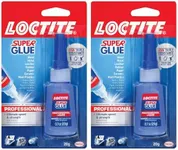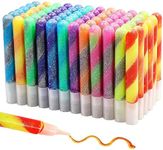Buying Guide for the Best Glue For Ceramics
When it comes to choosing the right glue for ceramics, it's important to consider the specific needs of your project. Ceramics can be delicate and require a strong, reliable adhesive to ensure a lasting bond. Understanding the key specifications of ceramic glues will help you make an informed decision and achieve the best results for your repair or crafting needs.Bond StrengthBond strength refers to the ability of the glue to hold the ceramic pieces together under stress. This is crucial because ceramics can be heavy and may need to withstand various forces. Bond strength is usually measured in PSI (pounds per square inch). For light repairs or decorative items, a lower bond strength (around 1000 PSI) may suffice. For functional items that will bear weight or be handled frequently, look for a higher bond strength (2000 PSI or more). Consider the intended use of the ceramic item to determine the necessary bond strength.
Drying TimeDrying time is the period it takes for the glue to set and achieve its initial bond. This is important because it affects how long you need to hold the pieces together and how quickly you can use the repaired item. Fast-drying glues can set in a few minutes, which is ideal for quick fixes or when you need to move on with your project quickly. However, slower-drying glues, which can take several hours, often provide a stronger and more durable bond. Choose a drying time that fits your project timeline and patience level.
Water ResistanceWater resistance indicates how well the glue can withstand exposure to moisture. This is particularly important for ceramics that will be used in kitchens, bathrooms, or outdoors. Some glues are water-resistant, meaning they can handle occasional splashes or humidity, while others are waterproof and can be fully submerged without losing their bond. If your ceramic item will be exposed to water, opt for a waterproof glue. For items that will stay dry, water resistance may not be as critical.
Temperature ResistanceTemperature resistance refers to the glue's ability to maintain its bond under varying temperatures. This is essential for ceramics that will be exposed to heat, such as dishes, mugs, or outdoor decorations. Some glues can withstand high temperatures without breaking down, while others may become brittle or lose their adhesive properties. If your ceramic item will be exposed to heat, choose a glue with high-temperature resistance. For items that will remain at room temperature, this may be less of a concern.
TransparencyTransparency is the clarity of the glue once it has dried. This is important for aesthetic reasons, especially if the glue will be visible on the repaired item. Transparent glues dry clear and are ideal for visible repairs, ensuring that the bond lines are not noticeable. Opaque glues may leave visible marks, which can be acceptable for non-decorative items or where the bond lines will be hidden. Consider the appearance of your finished project when deciding on the transparency of the glue.
Ease of ApplicationEase of application refers to how simple and convenient it is to use the glue. This includes factors like the packaging, applicator type, and viscosity of the glue. Some glues come with precision tips for detailed work, while others may have brush applicators for larger areas. Thicker glues are less likely to run and are easier to control, while thinner glues can penetrate small cracks more effectively. Choose a glue that matches the complexity and scale of your project, ensuring that you can apply it accurately and efficiently.













![[5oz Jar] Collectible Gel to Stabilize & Protect Treasured Items - for Home Decor- Clear Removable & Reusable - for a Variety of Surfaces](https://images-proxy.bestreviews.guide/rkggt1CNebGiSwG72SVm_o5QuaE=/0x150/https://m.media-amazon.com/images/I/41SZb6oc0UL._AC_CX679_.jpg)






